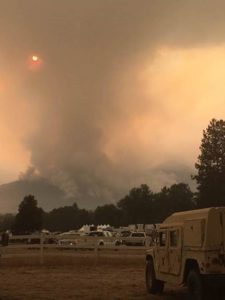
Fires blaze from the Blacktail Fire, located in the Blacktail Creek area, east of Loco Mountain in the Crazy Mountains, in Montana. The Blacktail Fire engulfed a little over 5,000 acres, with over 1 million acres impacted across Montana through various wildfires.

The Lolo Peak Fire, southwest of Lolo, Montana, has impacted over 53,000 acres. The National Guard was activated to help with evacuation efforts near the wildfire.
In addition, the FSA Emergency Conservation Program provides funding and technical assistance for farmers and ranchers to rehabilitate farmland damaged by natural disasters. Low-interest emergency loans are available to help producers recover from production and physical losses. Compensation is also available to producers who purchased coverage through the Noninsured Crop Disaster Assistance Program, which protects non-insurable crops (including native grass for grazing) against natural disasters that result in lower yields, crop losses or prevented planting.
As a result of the ongoing drought conditions, all Montana counties were approved for emergency haying and grazing of Conservation Reserve Program (CRP) acres. Due to drought and fire conditions, 53 of the state’s 56 counties have been declared either primary or contiguous disaster areas.
“The short term impact is FSA can do a lot of good for producers. Producers can get some relief, fix fences and get feed purchased,” Garcia said.
Garcia said hay donations came into the state from other areas to help out ranchers in need. Additionally, FSA employees from other states, including Missouri and Oklahoma, have spent time helping Montana producers enroll in FSA disaster programs.
“It is proof that the agriculture community is one big small town where you have a lot of folks that have camaraderie,” he said.
Detailed information on all of these disaster assistance programs can be found online at: www.fsa.usda.gov/disaster. Or at the USDA Disaster Resource Center.





